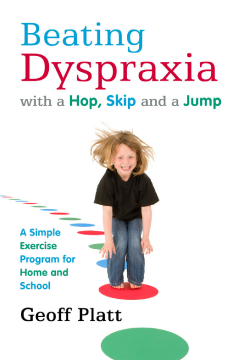
Additional Information
Book Details
Abstract
Children with dyspraxia often have reduced motor skills including balance, timing and coordination, as well as weak muscles - something recent research suggests may be not only a symptom but a cause of the condition. It is no wonder then, that they will do everything in their power to avoid gym class! By encouraging children with dyspraxia to take part in an easy and fun exercise program, teachers and parents can help them to overcome their symptoms, enjoy physical activities, and become as active as their friends and classmates.
Geoff Platt's highly effective program aims to improve strength and fitness by focusing on familiar activities such as running, jumping and ball play. These simple exercises can be taught by anyone and no specialist supervision or equipment is required. This book demonstrates how regular exercise routines that are tailored specifically to the needs of children with dyspraxia can make a real difference, eliminating weakness by improving muscle activation, neural control and overall movement skills.
This practical guide will be an essential resource for parents, Physical Education teachers, and other teachers of recreation and games classes who are looking to help children with dyspraxia to reduce weakness and improve motor skills.
This is a well-researched book that gives a much needed insight into dyspraxia. It details a straightforward strength and fitness programme and explores the ways in which regular exercise can make a significant difference in the lives of young people with dyspraxia. The background to dyspraxia and the importance of exercise are explained in detail. This gives valuable insight into the experiences of young people... this book should be read by anyone who is, or could be, teaching a young person with dyspraxia... it is easy to understand and written in such a way that the key messages are not lost.
Physical Education Matters
Geoff Platt, PhD, has worked as a lecturer in Sport Science for ten years, most recently working as a senior lecturer and course director in Sports Coaching Science and Sports Analysis and Coaching at Kingston University, London. He has lectured on Olympic Solidarity Courses on behalf of the International Olympic Committee and is the Director of Coaching for Weightlifting in Wales, Scotland and Northern Ireland. He has just completed a PhD for which he carried out extensive research into strength exercises for children with dyspraxia. Geoff lives in Surrey, UK.
This insightful and practical guide will arm the reader with a detailed knowledge of dyspraxia's symptoms, its history, and the conflicting diagnoses surrounding its still unknown causes, plus a recommended exercise program designed by Platt to beat the disability... Complete with helpful illustrations, photographs, diagrams, figures, tables, and bulleted and numbered lists, this guide is extremely educational in terms of background... during his research and is an expert on dyspraxia. His dedication to uncovering a cause and a cure for this condition is admirable, and anyone who suffers from, or knows someone who suffers from, dyspraxia should read this guide.
Foreword Reviews
The author describes muscle weakness as one of the major causes of dyspraxia and gives practical, easy, and fun, exercises to build strength and endurance and at the same time, confidence.
Sensory and More, www.sensoryandmore.com
Platt offers an insightful overview of issues faced by individuals with dyspraxia, a condition that is not well understood even by specialists... [His] exercise program offers a simple and useful resource that can be applied to a wide variety of settings, appropriate for children with typical development as well as those with dyspraxia.
Lisa A. Kurtz, M.Ed., OTR/L, FAOTA, paediatric occupational therapist and author of Understanding Controversial Therapies for Children with Autism, Attention Deficit Disorder, and Other Learning Disabilities
The book is aimed at parents, classroom teachers and P.E. teachers and provides them with exercises to improve strength and fitness by focussing on familiar activities such as running, jumping and ball play... The programme itself is simple and involves little in the way of equipment... This exercise programme would be of benefit to a wide population of children, not just those with dyspraxia and as such, it contributes to the body of work in this field.
SEN Magazine
